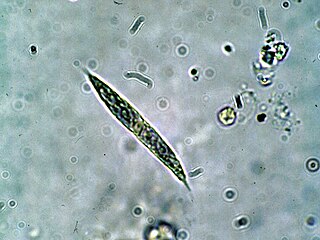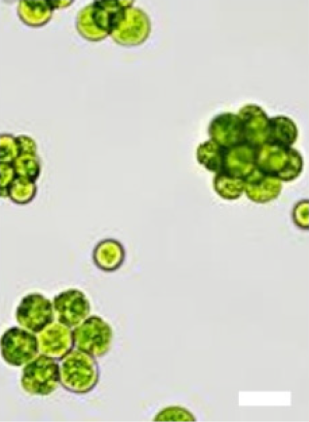
The Chlorophyceae are one of the classes of green algae, distinguished mainly on the basis of ultrastructural morphology. They are usually green due to the dominance of pigments chlorophyll a and chlorophyll b. The chloroplast may be discoid, plate-like, reticulate, cup-shaped, spiral- or ribbon-shaped in different species. Most of the members have one or more storage bodies called pyrenoids located in the chloroplast. Pyrenoids contain protein besides starch. Some green algae may store food in the form of oil droplets. They usually have a cell wall made up of an inner layer of cellulose and outer layer of pectose.

Chlamydomonas is a genus of green algae consisting of about 150 species of unicellular flagellates, found in stagnant water and on damp soil, in freshwater, seawater, and even in snow as "snow algae". Chlamydomonas is used as a model organism for molecular biology, especially studies of flagellar motility and chloroplast dynamics, biogenesis, and genetics. One of the many striking features of Chlamydomonas is that it contains ion channels (channelrhodopsins) that are directly activated by light. Some regulatory systems of Chlamydomonas are more complex than their homologs in Gymnosperms, with evolutionarily related regulatory proteins being larger and containing additional domains.

The glaucophytes, also known as glaucocystophytes or glaucocystids, are a small group of unicellular algae found in freshwater and moist terrestrial environments, less common today than they were during the Proterozoic. The stated number of species in the group varies from about 14 to 26. Together with the red algae (Rhodophyta) and the green algae plus land plants, they form the Archaeplastida.

Bryopsidales is an order of green algae, in the class Ulvophyceae.

Chlorococcaceae is a family of green algae, in the order Chlamydomonadales. They are mostly soil-dwelling algae. Many members of this group produce lipids and secondary carotenoids.
Actinochloris is a genus of green algae, in the family Actinochloridaceae, with a single species Actinochloris sphaerica. It is a subaerial to terrestrial alga.

Ankistrodesmus is a genus of green algae in the family Selenastraceae. It is one of the most common types of phytoplankton in freshwater habitats around the world. The name Ankistrodesmus comes from the Greek roots ankistron, meaning "cross", and desmos, meaning "bond".
Characiochloris is a genus of green algae in the family Characiochloridaceae. Characiochloris is epiphytic on freshwater algae, or found in soil.

Characium is a genus of green algae in the family Characiaceae. It is very commonly found in freshwater habitats, where it is attached to phytoplankton or zooplankton.

Quadrigula is a genus of green algae in the family Selenastraceae. It is commonly found in freshwater habitats as phytoplankton.
Tetracystis is a genus of green algae, in the family Chlorococcaceae. It is a terrestrial genus typically found in soils.

Tetraedron is a genus of green algae in the family Hydrodictyaceae. It may also be spelled as Tetraëdron.

Cosmarium is a large genus of desmids (Desmidiaceae), a group of green algae closely related to the land plants (Embryophyta). Members of this genus are microscopic and found in freshwater habitats around the world.

Actinochloridaceae is a family of green algae, in the order Chlamydomonadales.

Deasonia is a genus of green algae, in the family Actinochloridaceae. It is found in soils.
Deuterocharacium is a genus of green algae in the family Characiaceae. It is found in freshwater habitats, attached to algae or detritus. It is rare and has only been recorded from Europe.
Follicularia is a genus of green algae, in the family Schizochlamydaceae. It is found in terrestrial habitats, mainly soil.

Chlorokybus is a multicellular (sarcinoid) genus of basal green algae or charophyte. It has been classified as the sole member of the family Chlorokybaceae, which is the sole member of the order Chlorokybales, in turn the sole member of the class Chlorokybophyceae. It grows on soil and rock surfaces, and is rare.

Klebsormidium is a genus of filamentous charophyte green algae comprising 20 species. The name was proposed in 1972 to resolve confusion in application and status of Hormidium and was given for the German botanist Georg Albrecht Klebs.
Ilsteria is a genus of algae from the yellow-green algae class. It is a colonial organism, generally consisting of four or – sometimes – two cells. This genus is named after a Latvian botanist, teacher and poet Jānis Ilsters (1851–1889).












